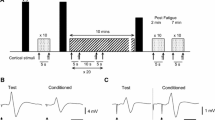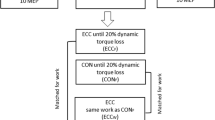Abstract
Magnetic stimulation of the motor cortex with electromyographic recordings from exercising muscles has shown corticospinal excitability to be depressed following exercise. We now investigate whether this depression spreads to non-exercising muscles and its influence on performance. Healthy volunteers made unilateral biceps curls to exhaustion and, in another later session, for 25% of the time to exhaustion. Bilateral motor-evoked potentials (MEPs) in biceps brachii and first dorsal interosseus muscles were measured at 2-min intervals before and after exercise. In another experiment, subjects performed exhaustive curls and, in addition to MEP areas, force production in biceps, hand-grip force, simple reaction times and movement times were measured bilaterally. MEPs were depressed after exhaustive exercise in the exercising biceps for over 60 min; depression was also observed 10–15 min after exercise in the non-exercising biceps but not in the first dorsal interosseus of either hand. The shorter exercise period produced depression of MEPs only in the exercising muscle. After exhaustive exercise maximum voluntary contraction fell in the exercising biceps and this correlated with MEP areas. No reduction in force was seen in the non-exercising biceps but hand-grip force fell slightly in both arms. There was no change in reaction times or movement times. Depression of MEPs can occur in non-exercising homonymous muscles but not in heteronymous muscles and only when exercise levels are high. There was no measurable functional deficit in the non-exercising limb, so we conclude that the reduced corticospinal excitability observed in this limb has little or no consequence on the performance parameters measured.





Similar content being viewed by others
References
Bigland-Ritchie B, Woods JJ (1984) Changes in muscle contractile properties and neural control during human muscular fatigue. Muscle Nerve 7:691–699
Bonato G, Zanette G, Manganotti P, Tinazzi M, Bongiovani G, Polo A, Fiaschi A (1996) ‘Direct’ and ‘crossed’ modulation of human motor cortex excitability following exercise. Neurosci Lett 216:97–100
Brasil-Neto JP, Pascual-Leone A, Valls-Sole J, Cammarota A, Cohen LG, Hallett M (1993) Postexercise depression of motor evoked potentials: a measure of central nervous system fatigue. Exp Brain Res 93:181–184
Cupido CM, Galea V, McCormas AJ (1996) Potentiation and depression of the M wave in human biceps brachii. J Physiol (Lond) 491:541–550
Day BL, Dressler D, Hess CW, Maertens de Noordhout A, Marsden CD, Mills K, Murray NMF, Nakashima K, Rothwell JC, Thompson PD (1990) Direction of current in magnetic stimulating coils used for percutaneous activation of brain, spinal cord and peripheral nerve. J Physiol (Lond) 430:617
Fulton RC, Strutton PH, McGregor AH, Davey NJ (2002) Fatigue induced changes in corticospinal drive to back muscles in elite rowers. Exp Physiol 87:593–600
Gandevia SC (2001) Spinal and supraspinal factors in human muscle fatigue. Physiol Rev 81:1725–1789
Hollge J, Kundel M, Ziemann U, Tergau F, Geewse R, Reimers CD (1997) Central fatigue in sports and daily exercise. A magnetic stimulation study. Int J Sports Med 18:614–617
Kauranen K, Siira P, Vanharanta H (1999) Strength training for 1 hour in humans: effect on motor performance or normal upper extremities. Eur J App Physiol 79:383–390
Kent-Braun JA (1999) Central and peripheral contributions to muscle fatigue in humans during sustained voluntary effort. Eur J App Physiol 80:57–63
McKay WB, Tuel SM, Sherwood AM, Stokic DS, Dimitrijevic MR (1995) Focal depression of cortical excitability induced by fatiguing muscle contraction: a transcranial magnetic stimulation study. Exp Brain Res 105 :276–282
McKay WB, Stokic DS, Sherwood AM, Vrbova G, Dimitrijevic MR (1996) Effect of fatiguing maximal voluntary contraction on excitatory and inhibitory responses elicited by transcranial magnetic stimulation. Muscle Nerve 19:1017–1024
McKenzie DK, Bigland-Ritchie B, Gorman RB, Gandevia SC (1992) Central and peripheral fatigue of the human diaphragm and limb muscles assessed by twitch interpolation. J Physiol (Lond) 454:643–656
Sacco P, Thickbroom GW, Byrnes ML, Mastaglia FL (2000) Changes in corticomotor excitability after fatiguing muscle contractions. Muscle Nerve 23:1840–1846
Samii A, Wassermann EM, Ikoma K, Mercuri B, Hallett M (1996) Characterisation of post-exercise facilitation and depression of motor evoked potentials to transcranial magnetic stimulation. Neurology 46:1376–1382
Samii A, Canos M, Ikoma K, Wassermann EM, Hallett M (1997a) Absence of facilitation or depression of motor evoked potentials after contralateral homologous muscle activation. Electroencephalogr Clin Neurophysiol 105:241–245
Samii A, Wassermann EM, Hallett M (1997b) Post-exercise depression of motor evoked potentials as a function of exercise duration. Electroencephalogr Clin Neurophysiol 105:352–356
Setyawati L (1995) Relations between feelings of fatigue, reaction time and work productivity. J Hum Ergol (Tokyo) 24:129–135
Strutton PH, Catley M, Davey NJ (2003a) Stability of human corticospinal excitability and grip force over a 24-hour period. Physiol Behav 79:679–682
Strutton PH, Catley M, McGregor AH, Davey NJ (2003b) Corticospinal excitability in patients with unilateral sciatica. Neurosci Lett 353:33–36
Tergau F, Geese R, Bauer A, Baur S, Paulus W, Reimers CD (2000) Motor cortex fatigue in sports measured by transcranial magnetic double stimulation. Med Sci Sports Exerc 32:1942–1948
Thayer R, Collins J, Noble EG, Taylor AW (2000) A decade of aerobic endurance training: histological evidence for fibre type transformation. J Sports Med Phys Fitness 40:248–289
Touge T, Taylor JL, Rothwell JC (1999) Reduced excitability of the corticospinal system during the warning period of a reaction task. Electroencephalogr Clin Neurophysiol 109:498–495
Zanette G, Bonato C, Polo A, Tinazzi M, Manganotti P, Fiaschi A (1995) Long-lasting depression of motor-evoked potentials to transcranial magnetic stimulation following exercise. Exp Brain Res 107:80–86
Author information
Authors and Affiliations
Corresponding author
Rights and permissions
About this article
Cite this article
Humphry, A.T., Lloyd-Davies, E.J., Teare, R.J. et al. Specificity and functional impact of post-exercise depression of cortically evoked motor potentials in man. Eur J Appl Physiol 92, 211–218 (2004). https://doi.org/10.1007/s00421-004-1082-9
Accepted:
Published:
Issue Date:
DOI: https://doi.org/10.1007/s00421-004-1082-9




